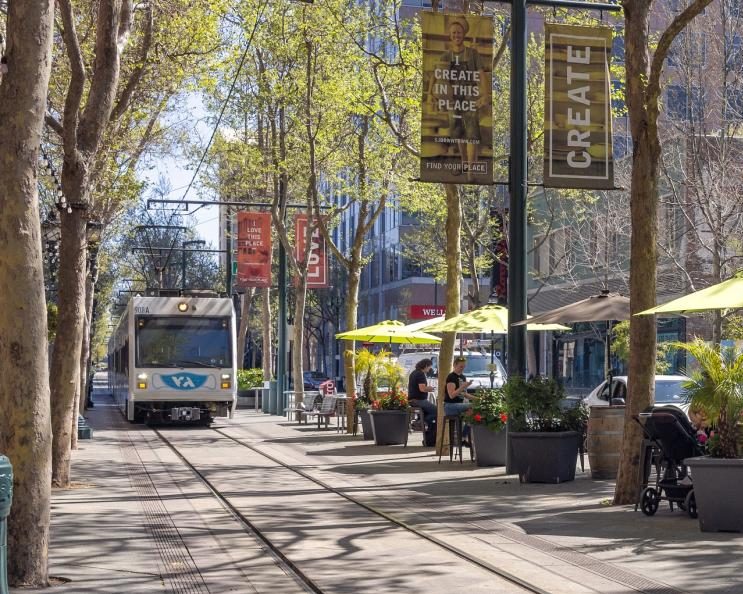A version of this post originally appeared on TransForm's blog. It is republished here with permission.
San Jose’s downtown and nearby neighborhoods are ready to thrive. Residents and visitors want lively streets with outdoor dining and cultural events. They want safe, fast bike and transit lanes. And they want plentiful homes, affordable to people of all incomes. But the potential to realize these opportunities often collides with a common concern: that there isn’t enough parking.
The reality, though, is that San Jose has an astounding amount of parking—1.9 million spaces for a city of around a million people! There is plenty of parking to go around, but unfortunately, spaces are used inefficiently so drivers may not be able to find convenient parking.
TransForm is spearheading a new partnership, SPOT SJ (Smart Parking for Optimal Transportation in San Jose) that will tackle these problems.
Over the past year, TransForm reviewed several parking tools recently developed by the private sector and found two—Parkade and Parknav—that can drive smarter decisions around the use of our public space. With these companies as well as three nonprofit partners—SPUR, Catalyze SV, and the San Jose Downtown Association, SPOT SJ will harness the power of technology to inform decision-making, engage the public, and make a more affordable, inclusive, and vibrant city. We are thrilled that the Mineta Transportation Institute (MTI) will lead the evaluation of the project as it will help us understand its benefits and challenges, allow us to improve the project and spread it to other cities.
SPOT SJ, made possible through a generous grant from The John S. and James L. Knight Foundation, has the potential to transform the conversation around parking in San Jose. This shift, we believe, will inspire concrete changes in how San Jose uses space, resulting in more affordable housing and more sustainable, equitable mobility—while also making parking less of a hassle.
Why make parking more efficient?
Building parking spaces increases construction costs (as much as $80,000 per spot!), making it harder for housing—especially affordable housing—to pencil out. And many of the features that would make San Jose’s streets more people-friendly, inviting, and safe—like bike lanes, bus lanes, parklets, or additional trees and outdoor seating—compete for space with those 1.9 million spaces. These same features can help create people-centered businesses and places thrive, think San Pedro Square.
But people who drive often feel frustrated by their inability to find on-street locations to store their vehicle, ( i.e., a parking space) right in front of their destination. That is why so many residents resist using parking for any other use and support building excessive parking in new structures.
This project will ameliorate this conflict in a few ways. First, by making it clear where and when parking is hard to find we can plan and manage street parking better. Second, a mobile app will help drivers navigate to streets or garages that have the most parking available, reducing time-consuming circling (and climate emissions). Third, the tools will allow building owners to better manage their existing parking, thus reducing the number of residents and employees “spilling over” into on-street parking. Finally, it will allow developers to build fewer parking spaces in future housing developments because they will be managed well adn because it will be easier for buildings and workplaces to “unbundle” parking—separating parking costs from housing costs, thereby reducing demand for parking, and encouraging more sustainable transportation.

Parknav uses big data and AI to analyze parking availability, both on the street and in garages. This information will allow planners and the community to have data-driven conversations about parking—showing what is available and when. Parknav can also forecast the effects of parking regulations or supply changes. This can mean easier parking during events, Sharks games, or construction projects like we are now seeing all over. Drivers will also be able to use an app powered by Parknav to find on-street and off-street parking in real time.

Parkade can reduce demand for on-street parking near existing buildings by making better use of parking lots and garages. It will also allow new buildings to build 25-30% fewer parking spaces, by making it efficient to share spots, and simple to unbundle parking from other costs.
Here are just a few things SPOT SJ will help accomplish in San Jose:
- Reduce the cost of housing development, allowing more affordable housing to be built, and give residents an income stream from renting their parking spots.
- Create more outdoor dining and events, green space, and other amenities that attract more people to downtown and support local businesses.
- Make existing parking lots more efficient, reducing spillover impacts on on-street parking.
- Use parking data in city planning to allow for more bike and transit lanes without creating big parking headaches.
- Develop an app to help drivers find available parking.
Together, we can create a community that is more vibrant and affordable, that creates less traffic and greenhouse gas emissions and makes parking easier to find for those who need it. SPOT SJ will have an initial planning focus on downtown and surrounding communities, though will promote the use of Parkade citywide.
To stay updated please email: SPOTSJ@TransFormca.org
Please contact us if you have any questions or feel you would have a good use for these powerful tools, especially if you would like to:
- See vehicle storage spaces converted to other uses, such as parklets for dining or bike lanes.
- Make better use of your existing residential or employee lots.
- Want to design housing with less (but better managed) parking.
***
Stuart Cohen is Founding Executive Director of TransForm






